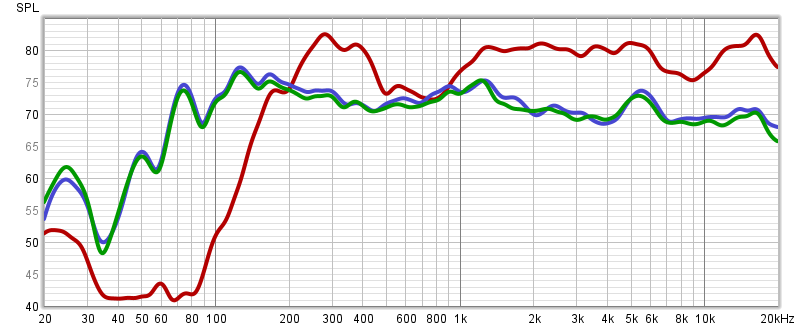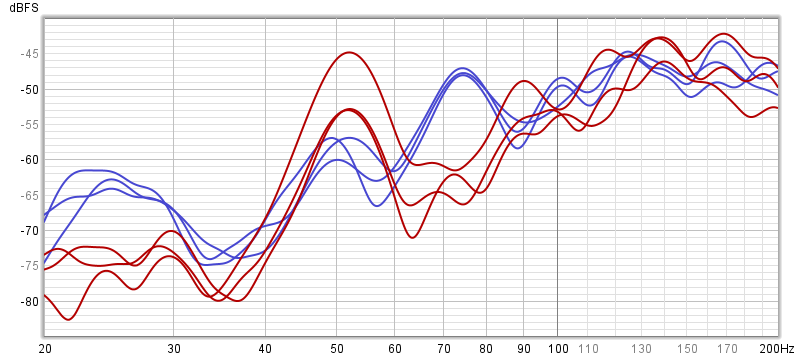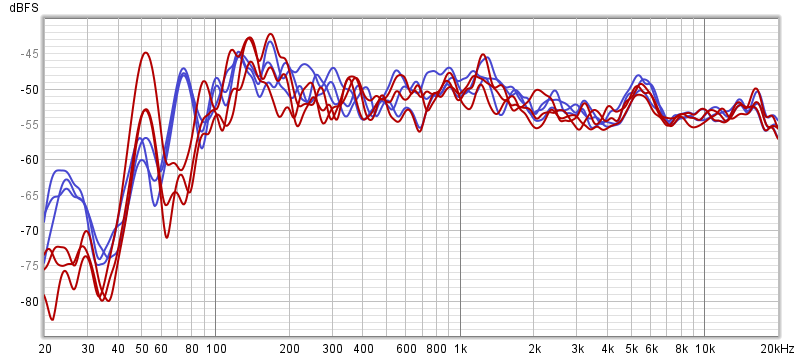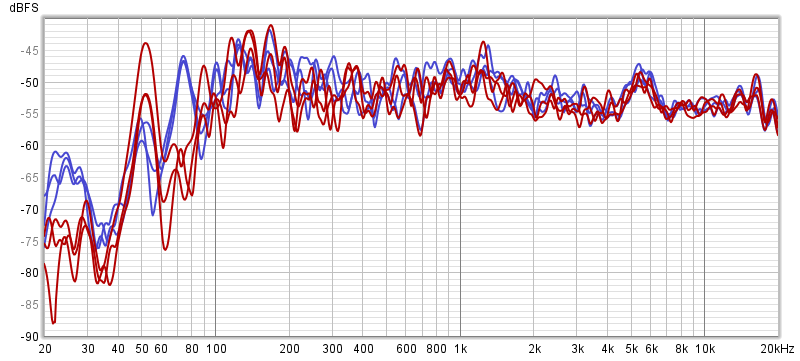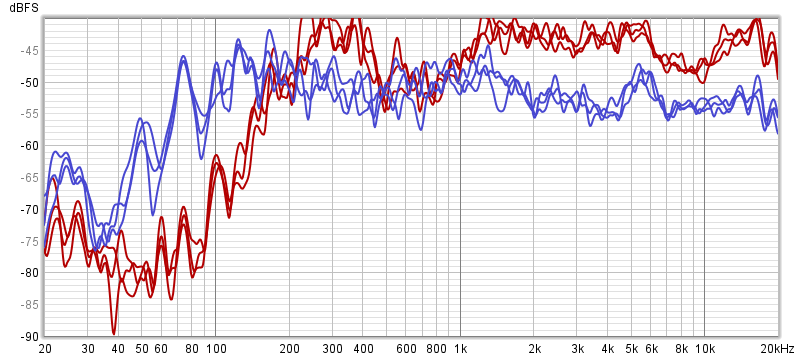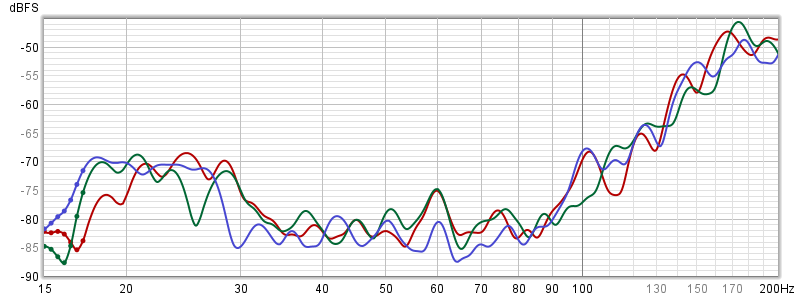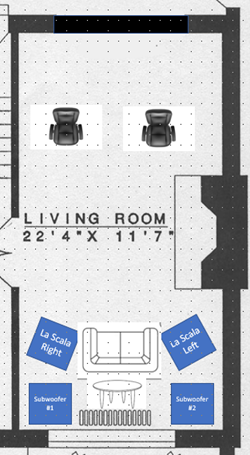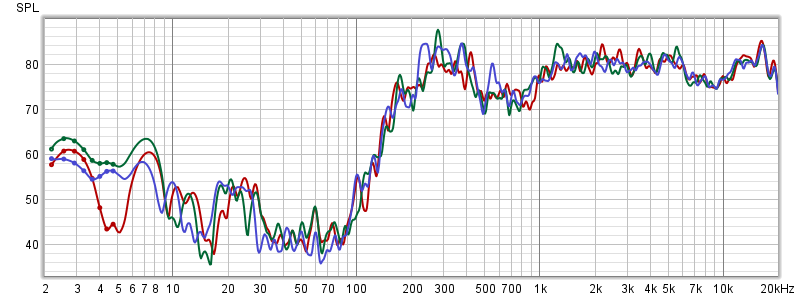
Dave MacKay
Regulars-
Posts
278 -
Joined
-
Last visited
Content Type
Forums
Events
Gallery
Everything posted by Dave MacKay
-
Using REW to Find Parametric Equalizer (PEQ) settings
Dave MacKay replied to Chris A's topic in Technical/Restorations
I appreciated the step-by-step approach. I've been learning REW for the past few weeks. It's a wonderful tool, but I find it very complex. It relies upon the user having a level of audio and mastering knowledge that I'm lacking. Clear, simple explanations help newbies like me.- 122 replies
-
- 2
-

-
- equalization
- rew
-
(and 1 more)
Tagged with:
-
La Scalas - surprising SPL graphs
Dave MacKay replied to Dave MacKay's topic in Technical/Restorations
The woofers are the original (1986) K-33-E. The screws on the access panel are tight. I will be replacing the gasket (which is original and is squished as thin as a playing card) with some 1 1/4" wide x 3/8" thick closed cell gasket tape when I veneer and refinish the speakers this spring. -
La Scalas - surprising SPL graphs
Dave MacKay replied to Dave MacKay's topic in Technical/Restorations
I’d like to thank the members of the forum (@henry4841, @yamahaSHO, @wuzzzer, @billybob, @captainbeefheart, @hanksjim1, @Shakeydeal, @Crankysoldermeister, @babadono, @Rudy81, @garyrc, @Rolox, @NBPK402, @RandyH, @pbphoto, and @Kalifornian) who contributed to this thread. The suggestions tended to deal with EQ, phase, speaker placement, and room treatment. · Given the layout and furnishings of the listening room, my options for placement are rather constrained. · Certainly, the room does need some acoustic treatment. In time, that will be addressed. · I’ve verified that the polarity of the AA networks and all of the drivers , including the woofers, is correct. · I’ve stopped using the EQ capabilities of my receiver and am now operating in Pure Direct mode (which bypasses all EQ and tone controls). My goal was to “dial in” my La Scalas before adding (and EQing) my two THTLP subwoofers. For the purposes of this exercise, I configured the amp for stereo only (no subwoofer). Initially, I used only a small set of the YPAO (Yamaha Parametric room Acoustic Optimizer) capabilities of my Yamaha R-N803 receiver. I thought that all I was doing was setting the distances and levels from the speakers to the listening position. I referred to this configuration as “YPAO neutral”. When I followed up on suggestions from @wuzzzer and others, I found that the YPAO was altering the signal quite a bit: it boosted the low-mids and high frequencies, but diminished the bass substantially. · the low-end performance of the La Scala dropped precipitously below about 200Hz and was pretty much non-existent below 100 Hz · frequencies above 1 kHz were boosted by about 5 dBFS · frequencies between 200 Hz and 500 Hz were also boosted I then turned the YPAO off and re-ran the tests. Finally, I put the receiver in Pure Direct mode so that the receiver bypasses all signal processing and routes the input signal directly to the amp. The YPAO and all tone controls are completely bypassed. This graph shows the results of the tests. For clarity, I averaged the results from each of the 3 microphone positions for each test and applied 1/6 smoothing. · The red line shows the results from the first (YPAO neutral) tests · The blue line shows the results from the YPAO off tests · the green line shows the results from the Pure Direct tests There appears to be little discernible difference between the YPAO off and Pure Direct amplifier settings. Both are a significant improvement over the results when the YPAO system was enabled. With my Yamaha R-N803 receiver configured in either YPAO off or Pure Direct mode, my La Scalas perform +/- 5dB from 64Hz to 18.5 kHz. I’m pretty satisfied with that. My next challenge will be to blend my two THTLP subwoofers with the speakers. Fortunately, that may not be as hard as I feared since, according to Yamaha, in Pure Direct mode the receiver still sends 100 Hz and lower to the subwoofer output. Since it’s clear that my room presents challenges at low frequencies, I expect I’ll need to make use of the EQ available from the SPA250DSP plate amps that power each subwoofer. Thanks to all for your help. -
La Scalas - surprising SPL graphs
Dave MacKay replied to Dave MacKay's topic in Technical/Restorations
Here is the 20 Hz to 20 kHz graph with 1/6 smoothing. Blue is the base case (YPAO off) and red is the base case with the phase of one woofer swapped. Here's a zoom-in from 20 Hz to 200 Hz of the same graph: What should I look for when measuring the speakers one at a time? -
La Scalas - surprising SPL graphs
Dave MacKay replied to Dave MacKay's topic in Technical/Restorations
The room certainly has issues and needs treatment. Because of WAF placement and room treatment are matters for negotiation. I'll discontinue using YPAO. I'll have to figure out how to meld my subwoofers into the system, but that's a challenge for another day. -
La Scalas - surprising SPL graphs
Dave MacKay replied to Dave MacKay's topic in Technical/Restorations
Yes, I loaded the calibration file. -
La Scalas - surprising SPL graphs
Dave MacKay replied to Dave MacKay's topic in Technical/Restorations
To see if the woofers in my La Scalas might be out of phase with each other, I reversed the positive and negative leads going to the woofer in my Right speaker. I flipped the leads at the network, as @captainbeefheart suggested. TLDR, I’m not sure but I think the woofers were in phase. I ran the test in direct stereo mode (i.e., all YPAO equalization turned off on the receiver). I’ve overlaid the base case (i.e., leads not swapped) in blue with the test case (i.e., leads swapped) in red on these graphs. The graph shows the results of that change: The blue and red lines are pretty close together above 125 Hz, but show some separation below that. Here’s a zoomed in portion of the graph, showing 20 Hz to 200 Hz: It seems to me that the blue lines (i.e., not swapped) look better. From these graphs, is it possible to tell if my woofers were out of phase? I’m guessing they weren't, but am not sure. -
La Scalas - surprising SPL graphs
Dave MacKay replied to Dave MacKay's topic in Technical/Restorations
I re-ran the “base line” test after ensuring that all YPAO equalization on my receiver was off. TLDR, performance was more consistent, a little worse at high frequencies and somewhat better for bass, but bass is still weak. I have overlaid yesterday’s results (in red) and today’s results (in blue) on the same graph. Here is the graph from 20 Hz to 20 kHz: What I noticed was: · frequencies between about 500 Hz and 1000 Hz are about the same · frequencies above 1 kHz have dropped by about 5 dBFS · frequencies between 200 Hz and 500 Hz are also lower · although the drop-off below 200 Hz is still there, the slope is less steep Since we are concentrating on the low frequencies, I have zoomed in to the portion of the graph between 20 Hz and 200 Hz: There is no question that today’s results (in blue) are better than yesterday’s results (in red). Today’s results show that: · my La Scalas perform at about -50 dBFS +/- 5 dB from 100 Hz to 17 kHz. · bass performance drops precipitously below 100 Hz. It’s down more than 10 dB by 50 Hz. · the La Scalas (with SMAHL tweeters and lenses) drop off slightly after about 17 kHz. That’s not a concern for me because it’s outside my hearing range. From this, it’s clear that, although the Yamaha YPAO system improves performance above 1 kHZ, it significantly impairs bass performance. I had wanted to be able to use YPAO because it enables me to specify where a cross-over frequency for LFE. And, sadly, the receiver’s user manual doesn’t specify what is sent out the LFE and when. I may have to contact Yamaha to see if I can continue to use the LFE output for my subwoofers, or if I’ll need to connect them in another fashion. I’ll make another post with the results from flipping the woofer wiring on one speaker (to investigate phase issues). -
La Scalas - surprising SPL graphs
Dave MacKay replied to Dave MacKay's topic in Technical/Restorations
Good idea. I'll try that. -
La Scalas - surprising SPL graphs
Dave MacKay replied to Dave MacKay's topic in Technical/Restorations
Visually, the speaker wiring from the amp to the networks, and from the networks to the drivers is correct. I can double check everything (except the network to woofer wiring) with a multimeter. I'd prefer to avoid having to flip the La Scalas upside down and remove the access panel to check the woofers until I've ruled out other possibilities. I could run the test with just one speaker to see if I still see the bass drop when testing the speakers one at a time. Would that be worthwhile? The YPAO on the receiver gives an out of phase error, but that's apparently pretty common. Since the wiring is correct, I figured the "out of phase" warning had to be due to reflections from hard surfaces in the room. -
La Scalas - surprising SPL graphs
Dave MacKay replied to Dave MacKay's topic in Technical/Restorations
My receiver is stereo only. It doesn't support HT, just 2.1 (i.e., stereo plus subwoofer). I can confirm that the speakers were set to Full Range on the receiver. -
La Scalas - surprising SPL graphs
Dave MacKay replied to Dave MacKay's topic in Technical/Restorations
I think that's what I did, but I'll do it again just to be sure. But, even if the receiver was messing with the signal, with the speakers set to Full Range and no subwoofer configured, it would't make sense for the receiver to throw away frequencies below 200 Hz --- unless there is something wrong (or misconfigured) with the receiver. I wonder if the fall off from 200 Hz matches a typical slope, such as 24 dB/octave? My La Scalas drop from around -50 dBFS at 200 Hz to -80 dBFS at around 90 Hz, which seems pretty close to 24 dB/octave. It seems like a long shot, but perhaps the receiver is fouling up the signal. -
La Scalas - surprising SPL graphs
Dave MacKay replied to Dave MacKay's topic in Technical/Restorations
My receiver has what's called YPAO (Yamaha Parametric room Acoustic Optimizer), not Audyssey. I mistakenly called it Audyssey because that's what my Denon home theatre receiver uses. I'll edit my original post to correct that. Nevertheless, I don't think that there is any unusual signal processing happening within the receiver. YPAO did set some parameters such as speaker distance (11' and 12') and levels (0 dB and +1 dB). -
La Scalas - surprising SPL graphs
Dave MacKay replied to Dave MacKay's topic in Technical/Restorations
I'd always thought that the bass was present, albeit fairly anemic. That's what drove me to get the THTLP subwoofers. I'll disconnect everything except the woofers to verify that the woofers are actually producing sound. How might I check the crossover networks? They're new; I got them from Crites in the summer. -
I recently tried characterizing the performance of my 1986 La Scalas using a calibrated UMIK-1 microphone and REW. The results surprised me so that I wanted to share them with the forum in the hope of eliciting some comments. TLDR: The La Scala bass performance was much worse than expected. Why? How can that be addressed? Results I took measurements with REW at 3 listening positions (left chair, right chair and in between the chairs; see positioning diagram, below). The measurements were taken with the amplifier set to full range speakers with no signal being directed to LFE for subwoofers. This graph (which uses 1/12 smoothing) shows that the low-end performance of my La Scala drops precipitously below about 200Hz and is pretty much non-existent below 100 Hz. For interest, here is the same data for frequencies below 200 Hz (i.e., zoomed in): Although these charts use a dBFS scale, the ones using an SPL scale are identical (see bottom of post). Clearly. my La Scala speakers perform poorly for frequencies below about 165 Hz (i.e., the lowest 3 octaves): performance drops from around -50 dBFS to around -80 dBFS. Do these results seem reasonable? I expected the La Scala’s bass to be OK until about 50 Hz but I was surprised to see their performance plummet below about 200 Hz. According to discussion on this forum, the La Scala stops acting as a horn below 104Hz (i.e., > 3.3m wavelength) and does not produce much bass below about 51 Hz (i.e., > 6.7m wavelength). However, my results show much poorer performance than that. I am interested in comments from forum members about these results. My system My 1986 La Scalas have new Crites AA networks and @Dave A's SMAHL tweeters and lenses. I laminated 3/8 Baltic Birch plywood to the exterior of the cabinet to improve rigidity. I’m driving the La Scalas with a Yamaha R-N803 100W/channel receiver. Although I have a pair of subwoofers, I turned them off for the test so that I could get a base line with just the La Scalas. I configured the amplifier to use Full Range speakers without subwoofers. The distance to the speakers as per the Yamaha’s YPAO (Yamaha Parametric room Acoustic Optimizer) tool was the same as I measured with my tape measure (roughly 11' to one and 12' to the other). As per YPAO’s recommendation, the Right speaker level was set 1 dB higher than the Left. Positioning This diagram shows my listening room: In the meantime I’ve been trying to blend my 2 THTLP subwoofers with the system, using the DSP features of the SPA250DSP plate amplifiers that power them. I may share the results I’ve achieved (so far) in a separate post. TLDR: music sounds anemic and lacking in bass when I get a flat SPL chart (20 Hz – 20 kHz). TIA for your comments and suggestions. In case you're interested - same charts but with SPL scale Here is the 20 Hz - 20k Hz chart using an SPL scale: Here is the 20 Hz - 200 Hz (i.e., zoomed in) chart using an SPL scale:
-
Today I added a second THTLP subwoofer: The box on the front of the subwoofer is a SPA250DSP plate amp. Here's a photo of it in place: The La Scalas are fantastic, but the La Scala/THTLP combo is incredible!
-
Differences and desirability of Heresy models?
Dave MacKay replied to Dave MacKay's topic in General Klipsch Info
I must have confused the two. Sorry. -
I'm curious about the differences --- and relative merits --- of different Heresy models. I've been watching items coming up for sale and have come across Model H (i.e., before it was branded Heresy) Heresy Heresy II The Heresy IIs seem to be listed for sale fairly frequently. I imagine that, generally speaking, the Heresy has gotten better over time and that the current model (Heresy IV) is the best of the lot. I also saw that Klipsch offers parts to upgrade a Heresy III to make it more like a Heresy IV. What are the merits of the different models? Is the Heresy II a good choice, or would one be better off waiting to find a Heresy III or other model?
-
I added subs to my Cornwall IVs and fell in love all over again
Dave MacKay replied to CoryGillmore's topic in Subwoofers
I had included the cost for two drivers and two plate amps in the costs I originally cited. I've since corrected the post. Sorry for my mistake. The cost to build the first THTLP was about US$985. The second one, that I'm having built, will cost about US$1500. Those prices include everything, even a 250W plate amp with DSP. -
I added subs to my Cornwall IVs and fell in love all over again
Dave MacKay replied to CoryGillmore's topic in Subwoofers
Just as a point of interest ... I built a THTLP a couple of months ago. I had the necessary tools and was able to build it in my garage. All told, it cost me about CAD$1250 (roughly US$985). I've been very pleased with the THTLP. I'm getting a second THTLP. Since it's too cold to work in my garage now, I've hired a builder to make it for me. He's charging me about CAD$650 (on top of materials) for the build, so that the second one will cost about CAD$1900 (roughly US$1500). The THTLP replaced an SVS SB1000 Pro subwoofer (roughly CAD$900) which is pretty much SVS' entry level subwoofer. The SVS was a good unit but was no match for my La Scalas. I don't know what commercially available subwoofer would be comparable to the THTLP, or what it would cost. -
CANADA Klipsch Forte IV Pair – American Cherry - Can $ 7998$ - That's 6281$ USD
Dave MacKay replied to OO1's topic in Alerts!
That's higher than the going rate at several other dealers in Canada. For example, Bay Bloor Radio (likely the largest high end retailer in Toronto) has them listed at CAD$7800. ** UPDATE ** Gibbys (the dealer that posted the FB ad) has lowered the price by CAD$200 so that it's more in line with other dealers. -
Using Klipschorns & La Scalas for a dance party
Dave MacKay replied to dug's topic in General Klipsch Info
Although I'm not operating a dance club, I'd suggest that you check out the plans from Bill Fitzmaurice for some DIY (or have someone build for you) subs. I have one (soon to be two) of his THTLPs. They have exceeded my expectations. -
Should I try this $275 folded horn sub with my La Scala?
Dave MacKay replied to Orbit's topic in Subwoofers
@ClaudeJ1, just trying to learn ... If the La Scala starts to drop off at 104 Hz, why wouldn't one want to set the cross-over around there (100 Hz - 110 Hz) while running the La Scala "full out" (without a high pass filter)? Not knowing any better, it would seem to me that doing so would let the sub would fill in from where the LS weakens. -
Today I bought a Bluesound Node. It was CAD$699, which was in line with what a DIY Raspberry Pi-based solution would have cost. I've had the biggest grin all day from listening to Tidal on it via Tidal Connect. The sound is spectacular! I'm happy I bit the bullet and got it. Highly recommended.
-
I had looked at the PecanPi but hadn't explored it in depth. I'd concentrated more on the HiFiBerry options. By my figuring, the cost of a DIY PecanPi, even if I repurposed a Raspberry Pi I already have, is pretty high: Volumio Premium (required for Tidal Connect) = $70/year PecanPi DAC (out of stock until March) = $350 Power supply = $30 Case = $50 XLR-to-RCA cable = $15 That works out to about $515 with an ongoing $70/year cost for Volumio Premium. The pre-packaged PecanPi streamer is about $650 plus $70/year for Volumio Premium. By contrast, a Bluesound Node costs about $550 with no ongoing costs. The Bluesound Node seems like a pretty nice device. I was hoping to find a less expensive way to test the waters.

